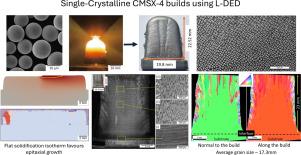使用激光定向能量沉积(L-DED)构建单晶镍基高温合金:一种多尺度建模和实验方法
IF 8.3
1区 材料科学
Q1 MATERIALS SCIENCE, MULTIDISCIPLINARY
引用次数: 0
摘要
增材制造正迅速成为生产复杂几何形状的可行替代方案,使其成为制造航空航天部件的潜在选择。喷气发动机中的高压涡轮叶片不仅几何形状复杂,而且对单晶度等微观结构要求也非常严格。拓扑结构和微观结构的复杂性使得确定这些叶片增材制造的正确工艺参数具有挑战性。在本文中,我们描述了一种用于识别这些参数的创新工作流程,包括在熔池长度尺度上基于物理的建模以及在晶粒和枝晶长度尺度上的微观结构建模。我们引入了一种新的扩散界面模型来模拟多层增材制造过程中的熔池形状。在基于potts的微观组织模型中使用了从该模型获得的热历史来确定凝固过程中的近似织构。通过结合工艺和粒度模型,我们确定了单晶构建的参数空间。实验分析证实,所识别的参数产生单晶微观结构。此外,考虑CMSX-4合金所有成分的相场模拟中利用热历史来确定初级枝晶臂间距(PDAS),通过与实验测量的比较,可以验证由工艺模型得出的凝固条件。因此,建模和实验的互补使用提供了见解,允许识别适当的外延生长添加剂参数,并帮助设计构建复杂形状的策略。本文章由计算机程序翻译,如有差异,请以英文原文为准。


Single-crystalline Ni-based superalloy builds using laser-directed energy deposition (L-DED): A multi-scale modeling and experimental approach
Additive manufacturing is rapidly becoming a viable alternative for producing complex geometries, making it a potential choice for manufacturing aerospace components. The high-pressure turbine blades in a jet engine not only have complex geometry but also require stringent microstructural specifications such as single-crystallinity. The combination of complexities in the topology and microstructure makes it challenging to identify the right process parameters for the additive manufacturing of these blades. In this paper, we describe an innovative workflow for identifying these parameters, involving physics-based modeling at the melt pool length scale and microstructure modeling at the grain and dendritic length scales. We introduce a novel diffuse-interface-inspired model to simulate the melt pool shape during multi-layer additive manufacturing. The thermal histories obtained from this model are used in a Potts-based microstructure model to determine the approximate texture during solidification. By combining the process and grain-scale model, we determine the parameter space for single-crystalline builds. Experimental analysis confirms that the identified parameters yield single-crystalline microstructures. Furthermore, the thermal histories are utilized in phase-field simulations that consider all the components of the CMSX-4 alloy to determine the primary dendrite arm spacing (PDAS), which, upon comparison with experimental measurements, serves as validation of the solidification conditions derived from the process model. Thus, the complementary use of modeling and experiments provides insights that allow the identification of appropriate additive parameters for epitaxial growth and aid in designing strategies for building complex shapes.
求助全文
通过发布文献求助,成功后即可免费获取论文全文。
去求助
来源期刊

Acta Materialia
工程技术-材料科学:综合
CiteScore
16.10
自引率
8.50%
发文量
801
审稿时长
53 days
期刊介绍:
Acta Materialia serves as a platform for publishing full-length, original papers and commissioned overviews that contribute to a profound understanding of the correlation between the processing, structure, and properties of inorganic materials. The journal seeks papers with high impact potential or those that significantly propel the field forward. The scope includes the atomic and molecular arrangements, chemical and electronic structures, and microstructure of materials, focusing on their mechanical or functional behavior across all length scales, including nanostructures.
 求助内容:
求助内容: 应助结果提醒方式:
应助结果提醒方式:


